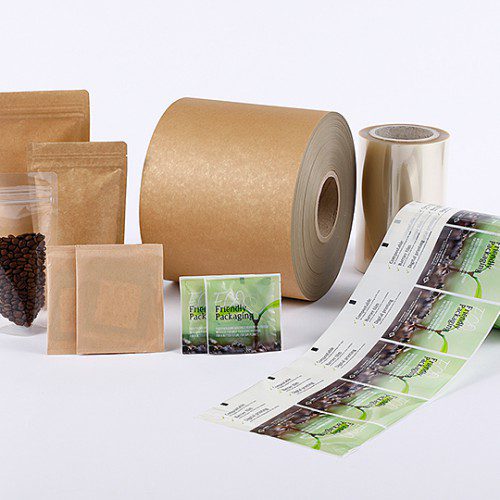The term “flexible packaging materials” refers to a class of wrappings that consist of several layers of synthetic polymers. This group of packages may contain combinations of several types of raw materials, such as paper, foil, polyethylene, fabric, polypropylene, etc.
Advantages of Flexible Goods Wrapping
The main advantages of flexible wrappers are their low weight and plasticity. Products are easy to transport, do not take up much space, and allow rational use of raw materials. Other pluses include:
– wide scope of application;
– beautiful appearance;
– he possibility of applying a bright design;
– friendliness to flexo packaging printing;
– wear and tear resistance;
– heat resistance;
– protection of goods from temperature extremes and humidity;
– high barrier properties.
Spheres of Application
– various confectionery products (chocolate, waffles, cookies, muffins, rolls, etc.);
– oil and fat goods (food with acetic/citric acid);
– groceries (dry food, semi-finished products, and canned food);
– basic household goods (soap, washing powder, matches);
– dry drinks and freeze-dried food (coffee, spices, various powder mixtures, etc.);
– dairy products;
– products for deep freezing;
– pharmaceutical goods;
– hygiene goods;
– building materials.
Depending on the goods to be wrapped, different flexible packaging types are chosen.
Common Types of Flexible Wrappings
1. Stand up pouches
This is a bulk three-seam polymeric (or combined) bag with one longitudinal (rear) and two transverse (upper and lower) seams and longitudinal recesses on both sides. When filled with a product, the bag expands and acquires a rectangular shape in its cross-section, and the bottom of the bag also becomes steady when put onto a flat surface. It is used to store bulk products, such as coffee, tea, cereals, sweets, and animal feed.
2. Flexible films
This is a special film on which the desired image is applied by printing. It ensures safety, provides goods with an attractive appearance, and is applicable to coating hygiene goods, frozen, bakery, and bulk products.
3. Foil packaging
Foil is distinguished by its protective properties. That is why it is often used in the food industry as a packaging material. It does not absorb fat and oil and does not allow air to pass through. When in contact with food, it does not produce harmful chemicals. For products containing oil or fat, as well as ice cream, meat, or tea, laminated foil is used; for medicines, blisters are applied; for fish, sweets, foil-coated cardboard, on which offset printing is possible is used.
Materials for Flexible Wrapping
1. POF
It is a transparent film on a cardboard sleeve, which shrinks on special equipment under hot air (sticks around the product), which gives the package a beautiful appearance and helps preserve the package from mechanical damages.
2. High-density polyethylene
This type of polyethylene is characterized by high-grade protection and applied for the manufacturing of containers and canisters.
3. Low-density polyethylene
It is used mainly in the production of both agricultural and technical films and food.
4. PET
PET containers are widely used as packaging for drinking and mineral water, vegetable oils, liquid food (ketchup, vinegar, mayonnaise, milk, beer), pharmaceuticals, cosmetics, and household chemicals.
5. Polypropylene
The material is used in the production process of containers designed to store beverages (bottles for drinks), oil, water, and other liquids. Cutting boards are also manufactured from polypropylene.
Common Technologies for Flexible Wrapping Manufacturing
In addition to the convenience of storage, the regarded type of wrapping makes the product stand out on the shelf in a store. Some polymers are difficult for conventional, lithographic printing. Flexographic inks allow users to print on any polymer container. Ten colors make it possible to create bright, individual designs. The following types of digital flexo printing are common:
– HD Flexo,
– Full HD Flexo,
– Multicolor,
– MetalFlex
How to Choose Flexible Wrapping?
Since this type of packaging has significant advantages over tin, glass, and plastic counterparts, more and more food manufacturers tend to use it. To enjoy all the advantages, it is important to choose wisely. When choosing, pay attention to the following requirements:
– the type of product;
– weight;
– shape and size;
– quality and composition of materials used in manufacturing;
– production technology;
– the possibility of recycling;
– safety, availability of appropriate certificates from the manufacturer.
Flexible wrapping is convenient because it allows for storing and transporting various kinds of goods, starting from food up to building materials and household goods. They provide high properties in terms of goods safety, protection from external influence, and are favorable to flexo printing. You can find wholesale packing options online with many different packing options.
Help keep news FREE for our readers
Supporting your local community newspaper/online news outlet is crucial now more than ever. If you believe in independent journalism, then consider making a valuable contribution by making a one-time or monthly donation. We operate in rural areas where providing unbiased news can be challenging. Read More About Supporting The West Wales Chronicle





















